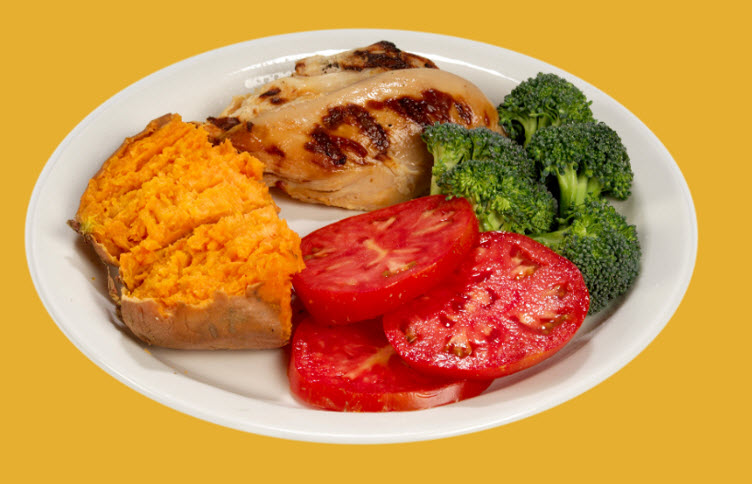Tips for Going Out to Eat
Going out to eat can be a fun part of life. You can stick to your healthy eating goals. Here are some tips for balanced restaurant meals to meet your goals.
How much should I eat?
• Remember restaurant meals are usually higher in calories than what you make at home. So, eat slowly and pay attention to your fullness. If you get full before the meal is finished, consider saving the rest for another time. Remember to follow food safety guidelines for storage. All-you-can-eat menu options and buffet-style restaurants may sound like a good deal, but they can make it easier to overeat.
• Try not to arrive at the restaurant overly hungry. It's harder to make healthy food choices when you get too hungry.
• Try not to be distracted while you eat. Instead of eating in the car, sit at the table. Take a break from work to enjoy your meal.
• Eat out no more than twice a week. Plan quick and easy homemade meals for busy days of the week.
• Choose the smaller size. Order a small instead of a medium. Have a junior burger instead of a regular burger. Choose a single patty instead of a double or triple. Order off the kids menu for a more modest portion.
• Consider dividing your meal into two meals! Most restaurants serve large portions. Split your meal with someone else, or, box up half your meal for the next day.
How do I make a balanced meal?

Gathany, J. (2010). 15030 [online image]. CDC Public Health Image Library. https://phil.cdc.gov/Details.aspx?pid=15030
Use the Plate Method to plan a balanced meal.
• Make ¼ of your plate protein foods. Proteins include meat, fish, eggs, tofu and beans.
• Make ¼ of your plate starch. Starches include bread, grains, and potatoes.
• Fill the rest of your plate with vegetables.
• Try having fruit, yogurt, or milk as a side instead of starchy items, like French fries. Many restaurants offer fresh fruit. Skim or low fat milk and yogurt are also healthy side dishes.
How can I keep my blood sugar in a healthy range?
• Restaurant meals usually have large starchy food servings. Breakfast starches include bread, biscuits, grits, oatmeal, pancakes and waffles. Starches at other meals include corn, potatoes, pasta, and rice. Remember a serving of starchy foods is just a handful. If you want two starches, choose smaller portions of each.
• Choose more non starchy vegetables with your meals. They are low in carbs. Examples include salads and grilled or steamed veggies.
• Include protein with your meal. Proteins include meat, beans, fish, eggs and cheese.
• Choose water, unsweetened tea, diet soda or diet lemonade.
• If you like sweet tea or coffee, use artificial sweeteners.
• Avoid soda, juice, lemonade, fruit punch, and sweet tea. They are high in sugar.
How can I choose lower sodium foods?
• Choose proteins that are lower in salt. Processed meats are high in salt. Processed meats include bacon, sausage, lunch meat, and hot dogs.
• Get sauces and condiments on the side. Then, you can decide how much to use.
• Gravies and Alfredo sauce are high in salt and saturated fat. Ketchup and barbecue sauce are high in salt and sugar. Stir fry sauces can be very salty. Choose these items less often or just have a small amount.
• Get salad dressing on the side so you decide how much you get. Aim for 1 or 2 tablespoons. Oil and vinegar are a great choice for dressing. Other dressings can have a lot of salt or sugar.
• Vegetable side dishes are often lower in salt. Try a salad instead of fries.
• Try flavoring foods with salsa, vinegar, and lemon juice.
What are other heart-healthy restaurant decisions I can make?
• Biscuits are always high in salt and saturated fat. When you can, choose plain bread or an English muffin.
• Choose grilled, broiled, steamed, or baked foods. Limit items that are fried, crispy, crunchy, battered, or breaded.
How can I find nutrition facts to guide restaurant food ordering?
• Look up nutrition info online before you go. Or, read the menu on the wall at the restaurant. All chain restaurants have to make sure nutrition information is available for you.
| DUHS Patient Education Governance Council approved 09/2020 | Flesch-Kincaid: 4.9 |
| Tips for Going Out to Eat | Population Health |
| Developed and approved specifically for DUHS patients and their loved ones | |
| Not intended for distribution or use by individuals outside of Duke Health |
Credits
- Current as of
- 01 18, 2026
- Author
- Medical Review
-